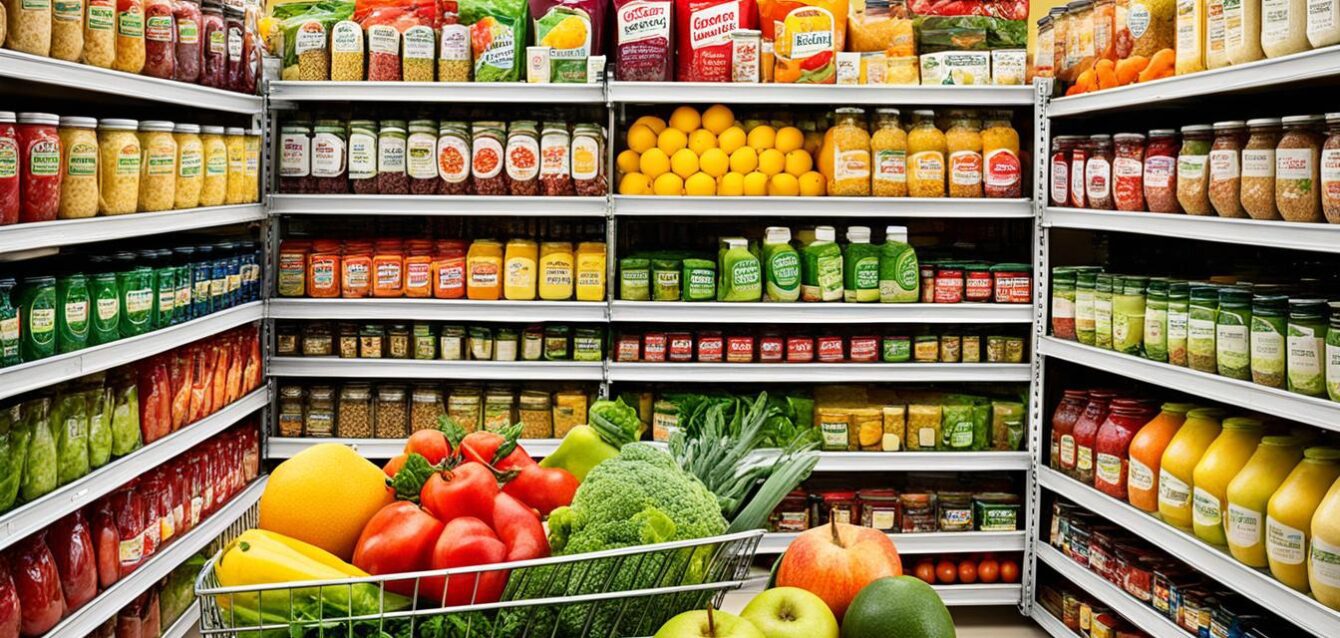The USDA predicts a 2% rise in food prices next year. This makes it crucial to manage your grocery budget well. By planning meals, buying local and seasonal produce, and choosing affordable protein and pantry items, you can save money. You won’t have to give up quality or taste.


This guide offers top tips and budget-friendly grocery advice to help you save at the supermarket. We’ll cover using in-season produce and frozen foods, finding affordable protein, and using coupons and cash-back apps. With these strategies, you can shop smart and enjoy tasty, healthy meals without spending a lot.
Shop Local and Seasonal Produce
Food prices are rising, but shopping at local farmers’ markets or joining a CSA program can save you money. Produce that’s in season is cheaper because it travels less. This makes it a smart choice for saving money.
Use the USDA’s Seasonal Produce Guide to see what’s in season near you. Then, go to your local farmers’ market or look into a CSA program. You’ll get fresh, affordable produce and support local farmers.
When you shop for seasonal produce, think about what’s in season and plan your meals. This way, you can save money and enjoy the best flavors of the season. By choosing local and seasonal produce, you get tasty, budget-friendly meals that are good for you and your wallet.
Smart Shopping Strategies

Shopping for groceries can be tough, especially with prices going up. But, you can save money with some smart tips. Start by planning your grocery list ahead and snapping a photo of your fridge and pantry. This helps you avoid buying things you don’t need and helps you not to overbuy.
Use coupons, cash-back apps, and store loyalty programs to save more. Many stores have weekly sales and discounts that can cut down your bill a lot. Also, try shopping mid-week when stores are quieter. You might find better deals on items that are close to expiring.
Don’t shop when you’re hungry to avoid buying things on a whim. Stick to your list and look for items on the upper and lower shelves. These are often cheaper than what’s at eye level.
By using these smart shopping tips, you can lower your grocery bills and make your money go further. With a bit of planning and paying attention, you can enjoy tasty, healthy meals without spending a lot.
Protein-Packed Options on a Budget
Looking for affordable protein sources? Check out your local grocery store. Ground beef, chicken, or turkey are great choices that won’t break the bank. Buying a whole chicken can also save you money, and you can use the bones for broth.
Eggs and canned seafood are also great for adding protein on a budget. Eggs are easy and cheap to add protein to your meals. Canned tuna, salmon, or sardines are also good choices because they’re affordable and full of protein. These foods help you get the nutrients you need without spending a lot.
When making your grocery list, keep an eye out for sales and deals on protein-rich foods. Try different cuts of meat or swap ground turkey for beef in your recipes. With a bit of creativity, you can make tasty, protein-packed meals that are easy on your wallet.
Embrace Plant-Based Proteins
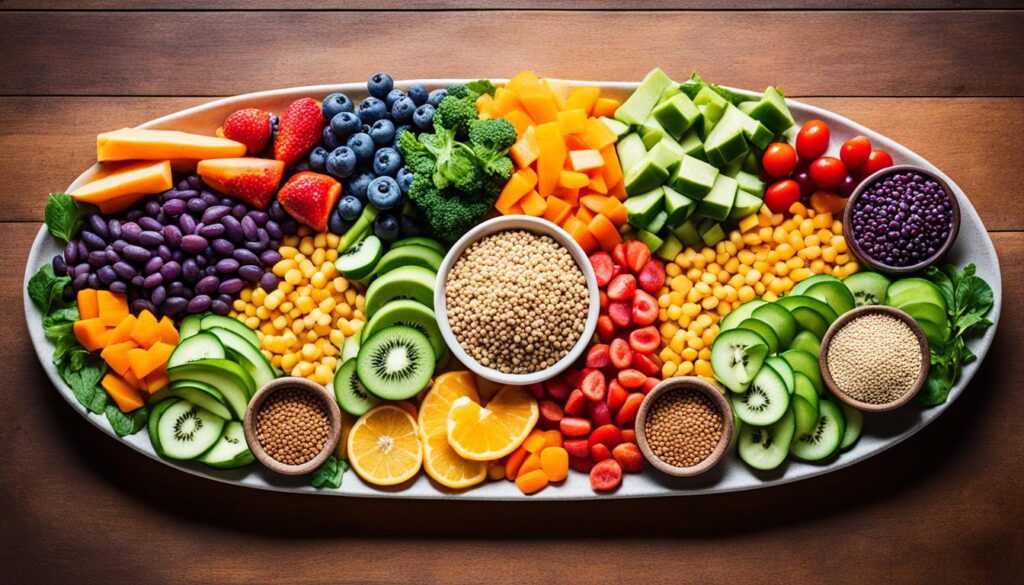
Adding more plant-based proteins like tofu, tempeh, beans, and legumes to your meals can save money and be healthier. Swapping meat for these options a few times a week can really cut costs.
The Bureau of Labor Statistics found beef was $3.71 per pound in October 2018. Beans were just $1.35 per pound. People who eat vegan or whole-food plant-based spend $750 less a year than meat eaters. By choosing plant-based proteins, you save money and get a diet full of nutrients.


When buying plant-based proteins, go for dried beans and lentils over canned to save more. Also, look for store-brand plant-based meat alternatives at places like Whole Foods, Trader Joe’s, and Publix. These are often cheaper than name-brand products.
Keep an eye on your spending and watch for discounts to save more with plant-based proteins. With creativity and a focus on whole foods, you can make tasty, affordable meatless meals. These meals are good for your wallet and the planet.
Cheap Grocery List to Save Money
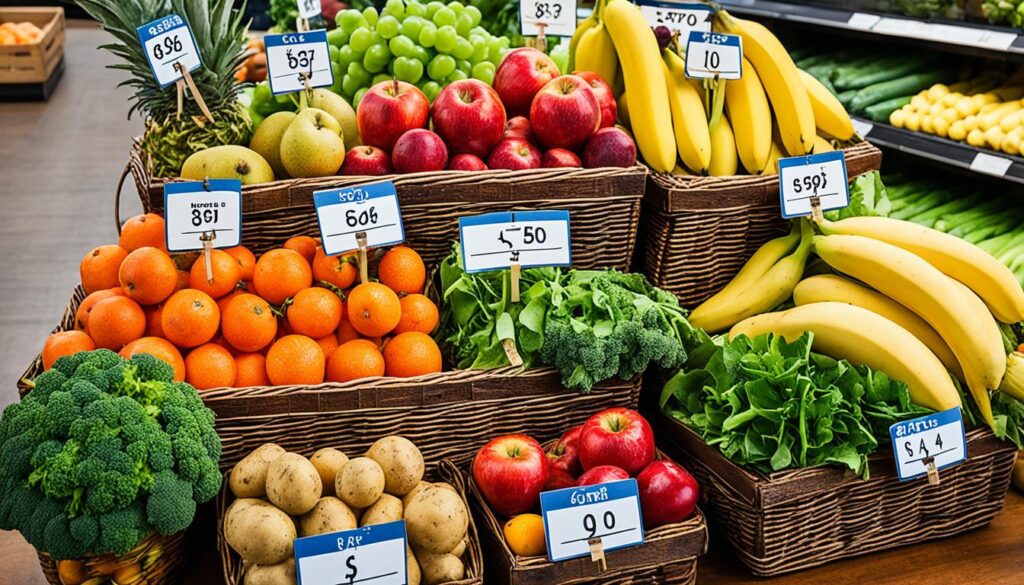
With grocery prices going up, planning your shopping list wisely is key. Items like oatmeal, brown rice, nuts, flour, and stock are very affordable. Dried and canned beans are also cheap and full of protein and fiber.
For a budget-friendly list, add pasta, tomatoes, lentils, and eggs. Spices, herbs, and vinegar can make simple dishes taste great. These pantry items let you make many tasty, affordable meals.
Choose ground meat, whole chickens, and pork shoulder for proteins that save money. Seafood like cod, flounder, and canned tuna is also affordable. Adding these items to your meals means you can eat well without spending a lot.
Seafood Savings

Seafood can make any meal tasty and healthy, but it can be expensive. Luckily, there are ways to make seafood more affordable. Buying frozen seafood is a smart move because it’s often cheaper than fresh.
Frozen fish like flounder or tilapia can save you money compared to fresh halibut or salmon. This is a great way to enjoy seafood without spending a lot.
Another way to save is by buying canned fish, such as tuna or sardines. These are not only budget-friendly but also easy to use for quick meals. It’s smart to buy seafood during its peak season to get the best prices.
For example, Alaskan salmon is cheaper in the summer. This can help you save money on your seafood purchases.
By trying these seafood saving tips, you can enjoy seafood’s health benefits without spending a lot. Whether you choose frozen, canned, or seasonal seafood, there are many affordable options for your meals.
Pantry Staples for Frugal Meals


Having a well-stocked pantry changes the game for budget-friendly meal planning. Items like oatmeal, rice, beans, and canned goods are key. They form the base for many affordable meals. These staples are not only budget-friendly but also open up a world of culinary possibilities.
A 5-pound bag of brown rice costs about $3.32. It’s a great grain option for many dishes, from rice bowls to casseroles. Adding a 15.5-ounce can of black beans for $0.69 gives your meals a protein boost. Canned tuna, priced at $6.84 for an 8-pack, is another affordable protein choice for sandwiches, salads, and more.
Buying versatile items like a 3-pack of 24-ounce traditional pasta sauce jars for $2.94 or a 32-ounce carton of chicken stock for $1.89 helps with budget-friendly recipes. These items make it easy to prepare nutritious meals without spending a lot.
Building a frugal pantry with budget-friendly, versatile ingredients is a smart move. These staples can be the base for many tasty, budget-friendly meals. They help you make the most of your grocery budget and save money over time.
Coupon Clipping and Cash-Back Apps


Smart shoppers use printable coupons, digital coupons, and cash-back apps to save money. Platforms like Ibotta and Rakuten offer great ways to stretch your budget. These apps and loyalty programs help you save more.
The Ibotta app lets users earn $10 to $20 a month, with some saving up to $300. Rakuten gives a $10 welcome bonus and $30 for each friend you invite. Dosh and Payce also offer rewards, like $1 for signing up and $5 after spending $20, not counting gift cards.
But it’s not just about cash-back. Grocery store loyalty programs can save you more. The Wells Fargo Active Cash® Card gives 2% cash rewards on all purchases, plus a $200 bonus after spending $500 in the first three months. The American Express Blue Cash Preferred® Card offers 6% cash back at U.S. supermarkets, up to $6,000 a year, and a $250 statement credit after $3,000 in purchases in the first six months.
Apps like Flipp give access to deals from over 2,000 stores, including Walmart and Walgreens. You can search for items, clip deals, and add loyalty cards to your list. With digital coupons and cash-back, saving on groceries is easy and convenient.
Store Brand vs. Name Brand

Shoppers are now choosing store brand products to save money on groceries. In 2020, there was an 11.4% increase in buying generic brands as food prices went up nearly 9% from the year before. Store brands are usually 20% to 25% cheaper than name brands.
Choosing store brands also means more than just saving money. A study showed 75% of people think store brands are just as good as big-name brands. Many store-brand items are made by the same companies that make name-brand products. This means they have the same quality and safety standards.
For expensive items, store-brand alternatives can save more than 50%. Buying all generic products for three meals a week could save over $11 a week. That’s $528 a year for a family of four. Stores like Trader Joe’s, Wegmans, and Costco have many loyal customers because of their quality store-brand products. They show that saving money doesn’t mean sacrificing quality or loyalty.
Bulk Buying for Long-Term Storage
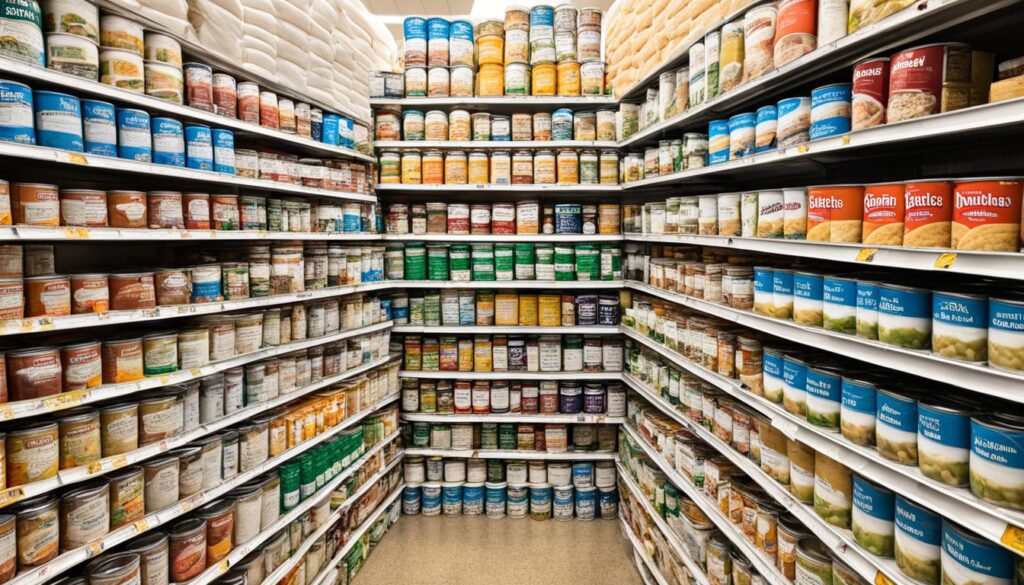
With grocery costs on the rise, buying in bulk can save you money. Items like beans, legumes, rice, oatmeal, and coffee are cheaper when bought in large quantities. This is true if you have enough space to keep them fresh for longer.
For the best bulk buying deals, you need to know where to look and how to store your items. Azure Standard offers both regular and bulk sizes for many foods. They’re based in Oregon and ship across the U.S. using UPS, USPS, and Drop Points.
For long-lasting foods, consider grains such as wheat, rice, flour, oats, and pasta. Also, think about dried beans, canned goods, oils, and quality sweeteners and salt. To keep these items fresh, use food-grade buckets, Gamma Lids, Mylar bags, oxygen absorbers, and strong shelves. Adding bay leaves to your containers can also keep pests away.
Bulk buying cuts down on food waste and saves money over time. By buying staples in bigger amounts, you get the benefit of a full pantry without the high costs. Plan your bulk orders well, aiming for 1-2 big orders a year for non-perishables. Add fresh produce and other perishables with monthly orders.
Mid-Week Shopping for Markdowns
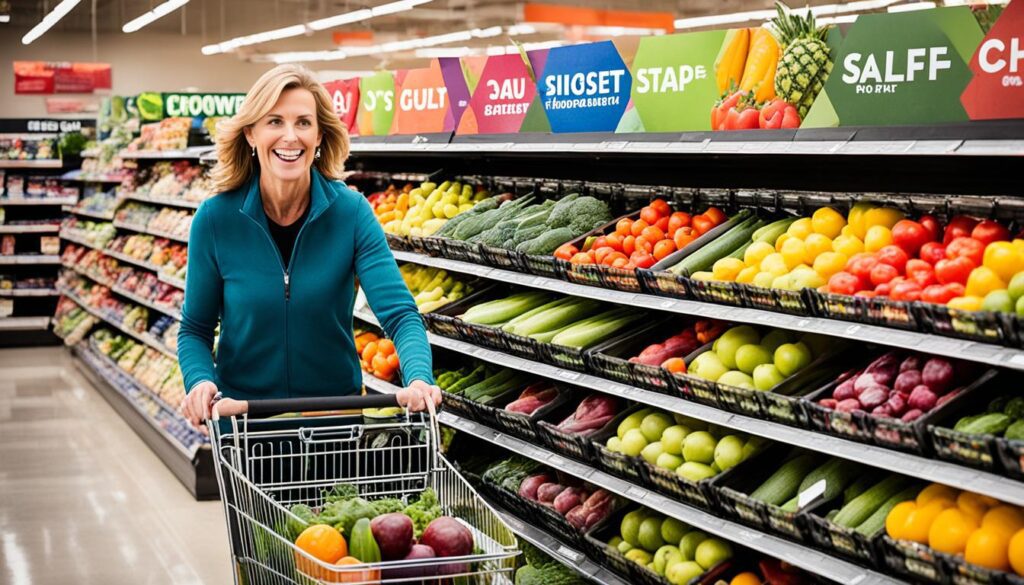
Shopping at the right time can save you a lot of money. Experts say the best time to go is mid-week. This is when stores put things on sale and clear out old stock. By shopping then, you can find lots of products at lower prices and save money.
Shopping in the middle of the week lets you see what’s new and on sale. Stores put items on sale if they didn’t sell well before or if they’re near their expiration date. Smart shoppers can find great deals on things like meat, fruits, and pantry items. Mid-week shopping is a great way to find these deals.
To make the most of mid-week shopping, time your visits well. Stores usually get new shipments on Tuesdays or Wednesdays. Going on these days means you’ll see the latest sales. This way, you can grab the best deals before they’re gone.
Online Grocery Shopping and Delivery


Online grocery shopping and delivery can change the game for saving money on groceries. Sites like Misfits Market, Boxed, Thrive Market, and Imperfect Foods offer discounts on many products. These online stores also have subscription programs for more savings and ease.
Shopping for groceries online helps you avoid buying things you don’t need. You can plan your shopping from home, sticking to your list and skipping in-store deals. Online stores show you prices clearly, making it easier to choose wisely.
Delivery costs can change, but many services offer free shipping on big orders. Stores like Walmart and Kroger have curbside pickup, which saves money compared to home delivery. By looking at all the options and their costs, you can pick the best online grocery service for your budget.
